As a result of our experiences, we have improved the itinerary and will take the tour again in 2000. Those who register for the tour will be sent a detailed information, maps and reading list to prepare them for the journey.
Valley of Happiness
revision 18 Mar 2001
http://www.greenkiwi.co.nz/footprints/frames/vh.htm
Having problems printing
this page?
After May 2000, we shall run this tour only
by special request.
We have now taken two groups into this very unique region.
If there is sufficient interest from four or more people
we would love to run the Kyirong tour in the future.
Please email us expressing your
interest
his region has only very recently been open to foreign visitors. In March of 1999 we took a group into the region, the second-ever that had been into the valley. Many locals that we met had not seen western people. It was like stepping backwards in time to a region that had changed little for hundreds of years.
As a result of our experiences, we have improved the itinerary and will take the tour again in 2000. Those who register for the tour will be sent a detailed information, maps and reading list to prepare them for the journey.
INTRODUCTION
![]() solated behind high mountains on the southern boundary
of Tibet there is a valley of surpassing beauty. A place for poets, encountered
by only a few explorers. A thousand years ago, it was here that Milarepa was
born and lived. Tibet’s beloved poet and mystic, sang his songs from cliffside
retreats that still resonate with his presence.
solated behind high mountains on the southern boundary
of Tibet there is a valley of surpassing beauty. A place for poets, encountered
by only a few explorers. A thousand years ago, it was here that Milarepa was
born and lived. Tibet’s beloved poet and mystic, sang his songs from cliffside
retreats that still resonate with his presence.

It is not without reason that Kyirong has been described as the ‘Valley of Happiness.’
This is a valley where giants of the Nepal Himalaya, Ganesh and Langtang, look
down on a lush landscape of fields and villages. With an altitude less than
3,000m it is one of the lowest places in all Tibet, and a climate that is ‘almost-tropical’
in the minds of wind-swept Tibetans from their high plateau. With such beneficence
it is not surprising that Heinrich Harrer, author of ‘Seven Years in Tibet’
said:
"I shall never cease thinking of this place with yearning,
and if I can choose where to pass the evening of my life, it will be in Kyirong."
![]()
![]()
The General Plan
![]() s to visit the Kyirong region of Tibet for three weeks in April-May 2000. We
drive northwards from Kathmandu, up the gorge of the Bhote Kosi (Tibet river)
onto the Tibetan plateau. We shall explore the nomad regions around Pelku Tso
lake, before crossing the high, and spectacularly scenic, Jakhyugn La (Hawk
pass) to Kyirong and ‘the Valley of Happiness’.
s to visit the Kyirong region of Tibet for three weeks in April-May 2000. We
drive northwards from Kathmandu, up the gorge of the Bhote Kosi (Tibet river)
onto the Tibetan plateau. We shall explore the nomad regions around Pelku Tso
lake, before crossing the high, and spectacularly scenic, Jakhyugn La (Hawk
pass) to Kyirong and ‘the Valley of Happiness’.
In the thirteen days that we are in the region there is sufficient time to explore
side valleys with day-walks and more longer excursions. We shall trek into the
Rap Nga valley where the icy peaks of Ganesh and Riwo Palbar rise sheer above
a wooded valley; traverse narrow ravines with hermit caves carved into the walls;
and visit monasteries perched on pinnacles of impossible steepness!

This is a region little travelled by foreigners since the time of Harrer; villagers
will be busy planting potatoes, buck-wheat and barley for the new season; on
the hills above, herds of yak graze beneath the ice-summits of Ganesh and Langtang;
and in the temples lamps are lit each day as they have been for over a thousand
years. Returning towards Nepal, we have two days to explore the region of Everest
Base Camp. Here, immediately beneath the rocky slopes of the world's highest
mountain we shall pay our respects at the famous monastery of Rongbuk.
This is a short driving tour to an accessible and magical part of Tibet.

It features, short walks into the side valleys of Kyirong and visits to isolated
villages and monasteries where foreign visitors remain rare. There is time to
acclimatise, to walk, to relax and to experience a genuine taste of Tibetan
life.
The Tibetan nomads....look like bandits with their swords tucked into their belts, their long unkempt hair, and their heavy wool and leather garments. Unsubmissive and restless, they are free masters of the vast silences on the roof of the world. They are the only people I envy: they are unfettered, serene in their inborn essential simplicity, ignorant of illusory architectures which time wears down and blows away like dust before the wind. As they wander throughout those immense spaces they seem to be suspended between heaven and earth.
Journey to Mustang 1952
Giuseppe Tucci
For those who have trekked with Footprints around Manaslu in/to Tsum, the Kyirong Valley is just beyond the easy pass that leads past Mu gompa into Tibet. Those who have been trekking with our ‘Rhododendron Rhapsody’ group can carry on to Tibet as an option, or the ‘Valley of Happiness’ tour can be experienced of it’s self.
WHERE DO WE TRAVEL?
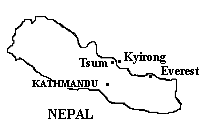
There is a total of three nights in Kathmandu and one in Bangkok before our
return to New Zealand.
![]()
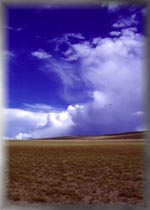
Beyond the slip and almost with relief, the road widens, the
valley broadens to become less vegetated and takes on the mottled brown habitus
of Tibet.

We are in a lovely settled valley. Stone walls define tiny fields which are
being prepared for planting. Such farms are not common in Tibet. Mostly the
country is too high to permit conventional agriculture. Here though, and in
the Kyirong valley, are exquisitely picturesque villages, clear rivers and high
mountains beyond.
It was the centre of the sky, The middle of the earth and the heart of the country. An enclosure of glaciers, the head of all rivers. High mountains, pure earth, an excellent country. A place where men are born heroes, Where custom is perfected, where horses grow swift.
Bon legend of Tibetan beginnings.
Kelly et al: Tibet . Reflections from the Wheel of Life
On the Tibetan
Plateau:
![]() he road switch-backs onto the open landscape of the plateau.
Near the road, massive glaciers descend from Mt Shishapangma as we head to our
lakeside camp at Pelku Tso. In 1999 on these sandy plains, we surprised a herd
of kiang (wild ass) who galloped past our astonished selves, before vanishing
into the hills. The Tibetan name for this lake, Lhatso Zitso, describes its
kidney shape. It is one of the most beautiful places I have been. On two sides,
jagged peaks spill their snow-waters abruptly towards the lake and on another,
the ice-bulk of Sishapangma is silhouetted against the morning sun.
he road switch-backs onto the open landscape of the plateau.
Near the road, massive glaciers descend from Mt Shishapangma as we head to our
lakeside camp at Pelku Tso. In 1999 on these sandy plains, we surprised a herd
of kiang (wild ass) who galloped past our astonished selves, before vanishing
into the hills. The Tibetan name for this lake, Lhatso Zitso, describes its
kidney shape. It is one of the most beautiful places I have been. On two sides,
jagged peaks spill their snow-waters abruptly towards the lake and on another,
the ice-bulk of Sishapangma is silhouetted against the morning sun.
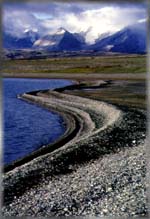
Sheep-herders graze their flocks along these slopes and from the campsite a
curve of lake is seductive invitation to wander.
The road winds up through a spectacular gorge of rocks folded like soft pink-and-golden
toffee to grind over the Jakhyung pass (5180m) and follow the Gyang Chu to administrative
town of Dzonka. Sitting on a high plateau between the Sarong and Kyirong rivers
Dzonka, called Kyirong Xian by the Chinese, is once again administrative town
for the region. We shall visit, but not linger, preferring to camp in a nearby
grassy valley. Here in a narrow defile are the cliff-homes of shepherds and
farmers for countless generations.
![]()
Into the Kyirong
Valley:
![]() rom Dzonka the road runs down the valley to Kyirong Qu.
The blue cockscomb of Ganesh Himal looms large on the right as we approach the
beautiful village of Orma. Up a side valley is Tsarang, the birthplace of Milarepa,
the region’s noted saint and poet. We shall visit this and several of his pilgrimage
sites, including the spectacularly sited Drakar Taso, ‘Eagles-nest’ hermitage.
rom Dzonka the road runs down the valley to Kyirong Qu.
The blue cockscomb of Ganesh Himal looms large on the right as we approach the
beautiful village of Orma. Up a side valley is Tsarang, the birthplace of Milarepa,
the region’s noted saint and poet. We shall visit this and several of his pilgrimage
sites, including the spectacularly sited Drakar Taso, ‘Eagles-nest’ hermitage.
We shall spend several days in one isolated valley where a magical combination
of picturesque villages, wooded slopes, high mountains and ridge-top temples
invites exploration.

The lower Kyirong valley, grows barley, potato and wheat, crops impossible only
a few kilometres further north. From here traditional trade routes here radiate
south to Nepal, towards the isolated highlands of Tsum in the west and north
to the Land of Snows. Despite tortuous gorges which separate it from Nepal,
the region was once a flourishing centre of trans-border trade: mostly wool
and salt from the north being exchanged for rice and manufactured goods from
the warmer south. Political difficulties have slowed commerce, but the signs
of old-wealth are still apparent.
We have thirteen days in this valley; thirteen days to explore an area inhabited for hundreds of years; an area where each village makes a tiny human scratch on the vast canvas of Tibet; there is history here and great beauty, rarely experienced by people from beyond.
To Rongbhu,
Everest Base Camp and return:
![]() n the northern side of Mt. Everest is Rongbhu Monastery.
This region was famous long before early British expeditions to the mountain
made it known to the west. The monastery, severely damaged during the Cultural
Revolution, has been largely restored to become a pilgrimage stop for mountaineers
en-route to the black slopes of Everest, just a short distance up-valley. This
is the 'world's highest monastery.' We shall have two days to make our bows
to the mountain before returning to Kathmandu.
n the northern side of Mt. Everest is Rongbhu Monastery.
This region was famous long before early British expeditions to the mountain
made it known to the west. The monastery, severely damaged during the Cultural
Revolution, has been largely restored to become a pilgrimage stop for mountaineers
en-route to the black slopes of Everest, just a short distance up-valley. This
is the 'world's highest monastery.' We shall have two days to make our bows
to the mountain before returning to Kathmandu.
![]()
Who was Milarepa?
![]() n 1052 a child was born in this region who was destined
to become celebrated throughout the Himalaya. Milarepa’s biography, full of
songs, humour and gripping tales became a source of countless ballads, folk
opera and art. His life occupies a loved and enduring place in the Tibetan imagination.
n 1052 a child was born in this region who was destined
to become celebrated throughout the Himalaya. Milarepa’s biography, full of
songs, humour and gripping tales became a source of countless ballads, folk
opera and art. His life occupies a loved and enduring place in the Tibetan imagination.
There is no doubt that he was a genuine historical character with a personality
that is both engaging and inspiring. In the latter part, his life expressed
an intense devotion to religion, learning and asceticism. His beginnings were
not so worthy.
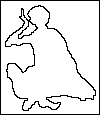
Born to a wealthy farming family in Tsalang near Dzonka, his comfortable childhood
was transformed when a wicked uncle dispossessed his widowed mother of her estate.
Reduced to servitude by this uncle his mother was consumed with revenge. She
encouraged the youthful Mila to sorcery and the black arts. With these magical
powers he was able to kill not only wicked-uncle but all that family and a multitude
of wedding guests as well! Not content with that, Mila’a mother roused him to
destroy the crops and houses of unhelpful villagers. She then repossessed the
household estates.
Overcome with remorse, Mila sought help from Marpa the renowned
teacher of the Kargyu school. Marpa’s training style for his new student was
rigorous. He set Mila to build a nine storey tower, ignored any complaint and
refused more conventional teaching. When the tower was completed Marpa ordered
it pulled down. This cycle was repeated several times over the years until Mila
was reduced to despair and contemplated suicide. Marpa relented, imparted formal
teachings and the new Mila went off to commence a life of renunciation and meditation.
Rejecting the world of comfort and family life, for him the things to be celebrated
were personal liberation and the glories of nature. He travelled extensively
throughout the Himalaya, teaching and meditating in numerous caves. Generations
of Tibetans followed his example of solitary meditation and multitudes of pilgrims
visit the sites made holy by the saints presence.
In solitary, stony fastneses among the mountains there is a strange market, where you can barter the vortex of life for boundless bliss.
Mila Repa (1052-1136)
Returning in the latter part of his life to the Kyirong valley,
Mila took up residence at ‘the Eagles Nest’, meditating there for twelve years.
Moving to the ‘valley of roses’ north of Everest, he died at the age of eighty-four
by knowingly taking poison offered by a jealous rival.
Usually depicted with right hand cupped to his ear and surrounded by animals
who came to listen to his songs the presence of this sage still echoes throughout
the region.
In the monastery of your heart and mind Lies a temple where all the Buddhas unite.
Mila Repa: Kelly et al: Tibet . Reflections from the Wheel of Life
What Else?
![]() aks we will certainly see in plenty. My very favourite beast
of burden Bos grunniens, the grunting cow, is everywhere in the high pastures
at this season. Their formidable horns belie a sweet temperament and their dainty
ankles a remarkable agility on mountain slopes.
aks we will certainly see in plenty. My very favourite beast
of burden Bos grunniens, the grunting cow, is everywhere in the high pastures
at this season. Their formidable horns belie a sweet temperament and their dainty
ankles a remarkable agility on mountain slopes.
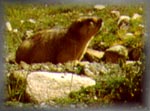
Hares, marmots and pika are smaller mammals that await the patient observer.
Fox families are delightful but alas elusive and the magnificent snow leopard
is now extremely rare in Tibet but, during the 2000 trek we found fresh snow
leopard scat! Antelope and the wild ass, kiang are usually seen. Flocks
of Snow Pigeons, Choughs and Crows fly noisily overhead, whilst soaring on updraughts,
gliding in graceful curves around the cliffs are the solitary Himalayan Griffon
and Lammergeier. These impressive birds can have wingspans of up to three metres,
greater than the less common Golden Eagle.
The next day I saw the most curious animal. I was walking along and saw these very tall animals, like giants. They each had one leg that was brown, and they all stood together in a line. They also had many arms reaching in all different directions. And their hair was many little green circles. I asked, "Brother, brother, what animal is this? Are they sleeping?"
Dolma Choetso, age 7 on first encountering a tree
Journey Through Holy Lands, Tricycle IV,4
Kathmandu
![]() he very first time I went to Nepal I was unprepared for the great
beauty of the Kathmandu valley and stupendous art within the triple cities of
Patan, Bhaktapur and Kathmandu. Kathmandu is a great and safe place to wander.
Artisans over the centuries have adorned the city's temples and houses creating
an open art gallery unlike anywhere else in the world.
he very first time I went to Nepal I was unprepared for the great
beauty of the Kathmandu valley and stupendous art within the triple cities of
Patan, Bhaktapur and Kathmandu. Kathmandu is a great and safe place to wander.
Artisans over the centuries have adorned the city's temples and houses creating
an open art gallery unlike anywhere else in the world.
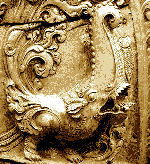
We have four days in Kathmandu to enjoy the crafts, taking the sights and delight
in the myriad of different peoples who look and dress in their own distinctive
tribal style.

We stay at the centrally located Malla Hotel which is quiet and very comfortable,
with a charming garden. Of all the Kathmandu hotels, the Malla has the best
combination of location, charm and cost.
![]()
Bangkok
![]() his city has a vibrant culture, superb architecture, friendly
people, great shopping and amazing food. I really enjoy Bangkok, but it also
has heat, humidity and horrendous traffic. At the Menam Hotel on the banks of
the busy Chao Phya river you can relax or be as active as you wish.
his city has a vibrant culture, superb architecture, friendly
people, great shopping and amazing food. I really enjoy Bangkok, but it also
has heat, humidity and horrendous traffic. At the Menam Hotel on the banks of
the busy Chao Phya river you can relax or be as active as you wish.

I have visited Bangkok many times and have developed the knack of enjoying this
marvellous place. During the day we have there I shall organise personal excursions
that can help you to enjoy it also.
![]()
Shopping
![]() here is time in Nepal and Bangkok to shop. Nepal is especially
great for handicrafts; carving, metalwork and jewellery, such as silver and
semi-precious stones. There are excellent hand-knotted carpets (made with New
Zealand wool) which are excellent buying. I shall give
indications of costs and 'best buys' in the trek notes issued to people travelling
on the tour. Bangkok has literally everything the world
produces. Handbags and designer clothing are particularly attractive for Kiwis.
Local markets are colourful, safe, have numerous 'finds' and are great fun.
here is time in Nepal and Bangkok to shop. Nepal is especially
great for handicrafts; carving, metalwork and jewellery, such as silver and
semi-precious stones. There are excellent hand-knotted carpets (made with New
Zealand wool) which are excellent buying. I shall give
indications of costs and 'best buys' in the trek notes issued to people travelling
on the tour. Bangkok has literally everything the world
produces. Handbags and designer clothing are particularly attractive for Kiwis.
Local markets are colourful, safe, have numerous 'finds' and are great fun.
![]()
How Difficult is the
Tour?
![]() ot difficult at all providing one is reasonably fit. Age is no
barrier if heart and lungs are healthy. Although this is not a walking tour,
we shall walk on a daily basis in Tibet and several small treks of three to
four days are contemplated. Day walks will be from one to five hours depending
on interests of the group and individual fitness. These will be walks to visit
nearby villages or monasteries, or for the sheer pleasure of being in an open
landscape free of noise and pollution. It is desirable therefore to have a reasonable
level of fitness and a good attitude towards walking. The more extended treks
will be more demanding but are entirely voluntary. If you are uncertain as to
just how you might function in these conditions please discuss the issues with
me. Our travel in Tibet will be in efficient Toyota Land Cruisers and we shall
camp each night in tents with comfortable mattress and sleeping bags. I am not
enthusiastic about hardship and don’t expect you to be either!
ot difficult at all providing one is reasonably fit. Age is no
barrier if heart and lungs are healthy. Although this is not a walking tour,
we shall walk on a daily basis in Tibet and several small treks of three to
four days are contemplated. Day walks will be from one to five hours depending
on interests of the group and individual fitness. These will be walks to visit
nearby villages or monasteries, or for the sheer pleasure of being in an open
landscape free of noise and pollution. It is desirable therefore to have a reasonable
level of fitness and a good attitude towards walking. The more extended treks
will be more demanding but are entirely voluntary. If you are uncertain as to
just how you might function in these conditions please discuss the issues with
me. Our travel in Tibet will be in efficient Toyota Land Cruisers and we shall
camp each night in tents with comfortable mattress and sleeping bags. I am not
enthusiastic about hardship and don’t expect you to be either!
When you embark for strange places, don’t leave any of yourself safely on shore. Be brave enough to live life creativly. The creative place is where no one else has ever been. You have to leave the city of your comfort and go into the wilderness of your intuition. You can’t get there by bus, only by hard work and risk and by not quite knowing what you’re doing. What you’ll discover will be wonderful. What you’ll discover will be yourself.
Alan Alda, addressing his daughters graduating class.
Mountain Record, Spring 97
What about Altitude?
![]() have been taking trekkers to Nepal since 1978 and have never
had anyone experience significant difficulties with altitude. The important
things are to have gradual ascent, time to adjust, rest days, and someone who
can recognise early problems. All these requirements are features of this tour
or indeed, any Footprints trek.
have been taking trekkers to Nepal since 1978 and have never
had anyone experience significant difficulties with altitude. The important
things are to have gradual ascent, time to adjust, rest days, and someone who
can recognise early problems. All these requirements are features of this tour
or indeed, any Footprints trek.
Because we are travelling by vehicle on this Tibetan tour these
comments are less pressing. It is a fact that there are less altitude problems
when not vigorously exercising.

However, I have deliberately addressed the acclimatisation issue by scheduling
two nights at Dhulikhel and Nyalam before we reach the more rarefied heights
of the Tibetan plateau. These two nights will more readily establish acclimatisation
than if we had proceeded directly to the Tibetan highlands. People respond differently
to altitude however, so on this tour if someone is not acclimatising well, it
is a relatively easy matter for one vehicle to return to lower altitude. It
is highly unlikely that this will be necessary. ![]()
What about the weather?
![]() n Spring snow covers the high mountains but the days are usually
fine with little likelihood of rain. At this altitude it will be chilly and,
as always in Tibet, there will be wind.
n Spring snow covers the high mountains but the days are usually
fine with little likelihood of rain. At this altitude it will be chilly and,
as always in Tibet, there will be wind. ![]()
What do we eat?
![]() ating is something that I regard as important for the whole tour.
On trek the meals are substantial and wholesome to replace the energy lost on
the trail. The cuisine is European with Nepalese overtones.
ating is something that I regard as important for the whole tour.
On trek the meals are substantial and wholesome to replace the energy lost on
the trail. The cuisine is European with Nepalese overtones.

It can be as bland or as hot as you wish. During our time in Tibet we shall
be accompanied by Sherpa staff from Nepal. Many of these men have travelled
with me for years. They have a high standard to personal hygiene and integrity
but fortunately, do not take the suggestions below literally!
But if one professes and practices living on the country one must take the rough with the smooth, rancid yak fat and frogs along with buckwheat cakes and rakshi.
H.W. Tilman: Nepal Himalaya, Cambridge 1952
In Kathmandu and Bangkok there is opportunity to be more adventurous.
Both cities have excellent restaurants that are inexpensive by New Zealand standards.
While on trek all meals are included. In the cities I make a feature of including
only breakfast in the tour cost. It is my view that prepaid organised meals
are usually inferior to hotel a la carte dining. In addition, organised meals
do not give opportunity to visit local restaurants outside the hotel. Local
restaurants are often more fun, have cheaper and better food, and give an opportunity
to mix with the locals. Don't imagine that Asian food is invariably hot, there
is plenty of restaurant choice in all cities. ![]()
![]() How
many people will go on this tour?
How
many people will go on this tour?
![]() he minimum client numbers for this trip is ten, maximum fourteen
he minimum client numbers for this trip is ten, maximum fourteen
![]()
Valley of Happiness,
Land only group
![]() hose who wish to travel elsewhere in Asia or travel on to Europe
may prefer this option. It includes all accommodation in Kathmandu with breakfast;
Kathmandu tours and other activities as for the main group; as well as the tour
costs, park and trek fees, and visa charges for Tibet.
hose who wish to travel elsewhere in Asia or travel on to Europe
may prefer this option. It includes all accommodation in Kathmandu with breakfast;
Kathmandu tours and other activities as for the main group; as well as the tour
costs, park and trek fees, and visa charges for Tibet.
N.B. If you choose the land-only option please organise your air travel early.
Flights to and from Asia are very heavily booked. I am happy to help with suggestions
and flight bookings if you wish.
Please note: These prices are those for the 2000 trek.
Valley of Happiness Land Only ex Ktm. 15 April to 10 May 2000 26day trip 3 nights in Kathmandu 21 days in Tibet 1 night Dhulikhel mountain resort about US$ 3653
depends on exchange rate
(note: US dollar rate is approx.)
What shall we tell you? Tales, marvellous tales, Of ships and stars and isles where good men rest, Where nevermore the rose of sunset pales, And winds and shadows fall toward the west.
The Golden Journey to Samarkand
James Elroy Flecker
Valley
of Happiness, Main group
Valley of Happiness Main Group ex NZ 14 April to 11May 2000 27day trip 3 nights in Kathmandu 1 night in Bangkok 21 days in Tibet 1 night Dhulikhel mountain resort NZ$ 9447
(note: NZ dollars)ex Auckland, Wellington or Christchurch
![]() hose who wish, might enjoy spending an extra three weeks prior
to Tibet by trekking in Nepal to see the rhododendrons which flourish at this
time of the year. This Rhododendron Rhapsody
tour preceeds the tour into Tibet, the two groups coming together in Kathmandu.
hose who wish, might enjoy spending an extra three weeks prior
to Tibet by trekking in Nepal to see the rhododendrons which flourish at this
time of the year. This Rhododendron Rhapsody
tour preceeds the tour into Tibet, the two groups coming together in Kathmandu.

Accompanying this rhododendron group will be our expert Himalayan botanist W.R.
(Bill) Sykes. Bill accompanied pioneering botanical expeditions to Nepal in
the 50’s. For the past six years he has provided expert support to my botanical
tours of Nepal.
The thirteen day trek is not particularly difficult but you do need to have
a good level of walking fitness both to participate and to enjoy walking through
this lovely terrain. If you are uncertain about whether or not you can deal
with the walking please get in touch with me.
The altitude throughout this trek never goes about 3000m. This perhaps sounds
a lot if you live at sea-level, but very few people have difficulty at these
heights. A bonus to those taking the rhododendron option is that they will be
acclimatised for the more rarefied airs of the Tibetan plateau.
Please note: These prices are for the 2000 trek. I reserve the right to make changes should major fluctuations occur in currency or air fares.
Valley of Happiness with preceeding Rhododendron option Land only ex Ktm 30March to 10 May 2000 42 day trip about US$5581
(note: US$ rate is approx)ex New Zealand 28 March to 11 May 2000 45 day trip NZ$13,159
(note: NZ$)
![]() hose who wish, may continue on to Lhasa after our visit to Kyirong
and Everest Base Camp.
hose who wish, may continue on to Lhasa after our visit to Kyirong
and Everest Base Camp.

There is a five day drive from the Base Camp to Lhasa, visiting the magnificent
temples of Shigatse and Gyantse before reaching the holy city, Lhasa. To more
fully enjoy this historic part of Tibet I have allowed an extra night at Shigatse.
Finally, there are three days to explore Lhasa before taking a spectacular flight
over Mt Everest to Kathmandu; with two days in Kathmandu to 'return to earth'!
Valley of Happiness including Lhasa option Land only ex Ktm 15 April to 17 May 2000 32 day trip about US$ 4770
depends on exchange rate
(note: US$ rate is approx)ex New Zealand 14 April to 18 May 34 day trip 28 days in Tibet NZ$11,663
(note: NZ$)
Valley of Happiness
What do you get...and, what you don't get?
For all groups
A personally guided introduction to some fabulous people and places with me!
· 1st class twin-share accommodation in all cities · full breakfasts in Kathmandu
and Bangkok · two half day tours in Kathmandu · one half day tour in Bangkok
· a celebratory group dinner in Kathmandu · all transportation within Tibet
and Nepal including flights · all meals while on trek or tour including Dhulikhel
resort · Tibet visa and all regional permits · all transportation, food and
travel costs while on tour.
The following applies to Main Group only
Return economy airfare from Christchurch, Wellington or Auckland to Nepal
· arrival visa in Kathmandu · airport transfers · departure taxes in Bangkok
& Kathmandu · baggage handling on arrival and departure in Bangkok & Kathmandu
The following applies to Rhododendron option
assistance of an expert in Himalayan botany · two person tent accommodation
on trek · use of down jacket, sleeping bag, kitbag, 'Thermarest' and padded
mat on trek · porters to carry all personal gear · porter insurance · comprehensive
group medical kit . all trek and regional permits.
Valley of Happiness Is it worth it?
What other information
do you send? If timing for this trip does not suit, please
email your wishes and we shall look
to provide a similar tour at a later time. top of page
site map contact us
Copyright © Footprints Tours Ltd
What you don't get
· NZ departure tax · meals unless stipulated · personal insurance
and medical expenses · emergency evacuation charges (covered by appropriate
medical insurance policy) · excess baggage charges and items of a personal nature.
![]()
![]()
![]()
![]()
believe this trip is excellent value. You are urged to compare
the quality and duration of the experience relative to what is offered by other
companies. There are no hidden expenses here and a lot of extras that you will
not find elsewhere. I have been visiting Nepal and Tibet for a long time and
know the value of unrushed travel using local guides who are personal friends.
There is time on this journey to enjoy some very special parts of the world
with someone who knows it well. I can guarantee experiences that will be treasured
for a lifetime. ![]()
![]()
![]()
![]() After registration I shall send pre-trek information including;
a daily tour itinerary; detailed information about what you need to prepare
and bring for this tour; a suggested reading list; information relating to health
issues and vaccinations.
After registration I shall send pre-trek information including;
a daily tour itinerary; detailed information about what you need to prepare
and bring for this tour; a suggested reading list; information relating to health
issues and vaccinations.
![]()
If you would like us to arrange this tour for your own
independent group check out what we offer.
Programming & design by Green Kiwi Ltd
Last updated: 18 Mar, 2001